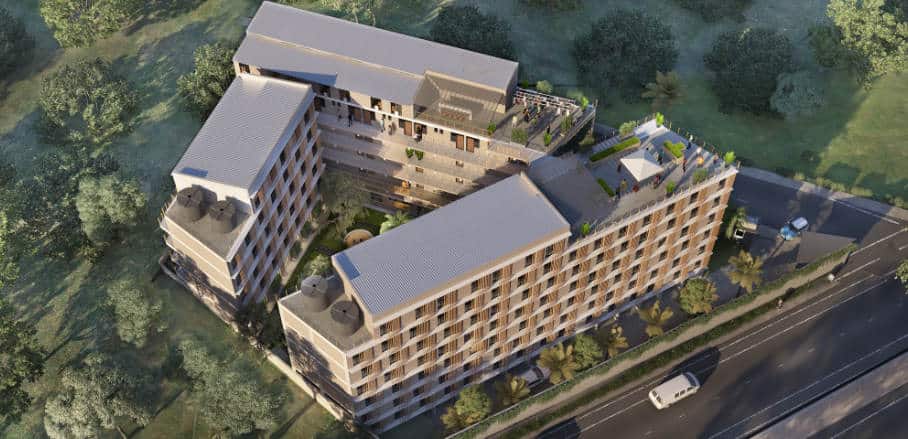Needing No Less Than a Revolution – Building For a Sustainable Future Climate
In order to get cities back on track to avoid building towards a climate crisis, actions must start today: Donovan Storey and Etta Madete Mukuba on sustainable design principles, alternative building materials, and technologies.
With COP27 taking place in Egypt, the discussion about how to still reach climate goals in critical sectors must gain new momentum. For example, meeting the housing needs of over one billion people, while supporting global climate goals, provides one of the most significant global challenges we have to face today. Yet it also offers some of the most transformational opportunities. For too long, affordable housing solutions have been delivered through high-carbon, low-quality and energy-inefficient materials which have resulted in unhealthy and poor-quality outcomes for the poorest, thus contributing further to the ‘poverty penalty.’
As approximately 70 per cent of buildings that will exist in Africa and Asia by 2050 are yet to be built, providing an alternative and investable green alternative to close global shelter deficits is essential, and urgent. To demonstrate and quantify the potential impact, the Intergovernmental Panel on Climate Change (IPCC) has estimated that mitigation policies have the potential to reduce 80 per cent of building sector greenhouse gas emissions, address energy poverty as well as provide opportunity through just transitions.
Building Towards a Climate Crisis
An estimated 39 per cent of global greenhouse gas emissions originate from the built environment. While progress has been made in recent years, the world is well off-track to meet its green infrastructure goals for 2050. This means in practice, that by succeeding in meeting the housing needs of urban populations through conventional means, materials, and businesses, we are essentially building our way to a climate crisis.
This is not inevitable. A trade-off between meeting shelter, resilience, and climate needs is no longer necessary or justified. In fact, meeting infrastructure and housing gaps must be seen as a catalyst for urban climate resilience and mitigation. In meeting future housing needs – estimated to be roughly more than three billion people by 2050 – there is still time to align the ambitions of Sustainable Development Goal (SDG) 11 and the Paris Agreement.
Refocusing Affordable Housing on Climate and Resilience Goals
Addressing affordable housing has also for too long been supply driven and based on off-the-shelf materials and delivery chains, crowding out the dynamic and creative builders and designers of future cities. Africa, where there is an overdue need to reassess urbanisation, is an important example of this trade-off. While over 150 million urban Africans have benefitted from improved housing over the past two decades, this has potentially locked in infrastructure and materials, which undermine climate and resilience goals at enormous cost. Some countries, such as Ghana, Rwanda, South Africa, and Kenya have started to realise the need to refocus on housing goals and carbon footprints. However, translating that understanding into action has been slow.
BuildX Studio, a design-build-develop B corp-certified company based in Kenya, has recently broken ground on an affordable housing project, Zima Homes, which aims to be an example of affordability, sustainability, and inclusivity. Planned for completion in 2024 the 137-unit development in Nairobi includes studios, one- and two-bed apartments, costing between 1.7 million Kenyan shillings (14,100 dollars) and 3.55 million Kenyan shillings (29,500 dollars). The project is transformative in the use of sustainable design principles, alternative building materials and technologies, and used inclusivity principles from design to construction.
Zima Homes – Exemplary Sustainable and Inclusive Building
Zima Homes are unique in that sustainability and inclusivity have been considered a priority from the onset in that innovation in design takes place within a framework of affordability. It also focuses on replicable materials and standards through modular structural grids, efficient ducting systems, and the use of prefabricated materials. This has enabled reducing the overall cost per unit in the use of sustainable and inclusive design, demonstrating that green and affordable housing is possible if design, material, and commerciality are considered from the outset rather than as part of ‘one-off’ demonstration projects.
A further critical innovation emerged in leveraging digital tools such as the green building certification system EDGE (Excellence in Design for Greater Efficiencies), and BIM-software Revit from the onset, to enable an efficient but still repetitive, analytical, and informative design process. On-site rainwater harvesting mechanisms, energy-efficient lighting, and water-efficient toilets are coupled with on-site recycling points. Finally, the use of local labour and materials reduces carbon emissions through transportation. Barriers still exist though in supply chains, notably the high capital costs of sustainable mechanical, electrical and plumbing systems (MEP).
Efficient Building as an Opportunity for Investment
Naturally, key gaps remain, for example, the lack of green finance that is reaching needs. Yet, the International Finance Corporation (IFC) has estimated efficient buildings provide a 24.7 trillion dollar opportunity for investment in emerging markets. Addressing building codes, supply chains, and capacity also requires attention, but the cost of business as usual is too high to justify any other proceedings. Change is underway as emerging entrepreneurs, small and medium-sized enterprises (SMEs), and a growing number of governments become increasingly aware that their built environment is no longer fit for purpose. However, this requires no less than a revolution in the global construction industry – in materials, design, and finance. COP27 has a critical role to play in accelerating this transition. There is still time to get cities back on track, to build our way toward more sustainable and inclusive cities of tomorrow – but those actions must start today.
- Resilient Cities are Green Cities - 2. July 2020
- Circular Economies as an Answer to the Waste Crisis: Lessons Learnt - 21. April 2020
